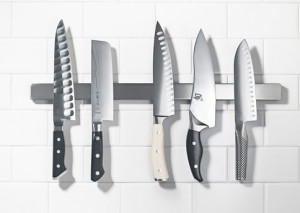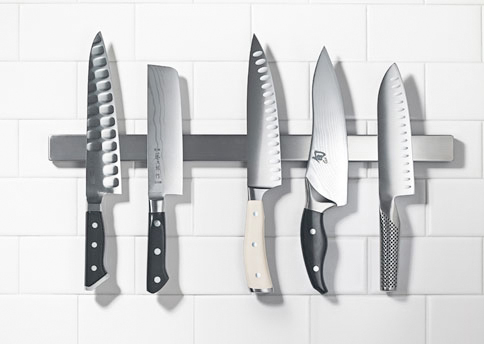The chef’s knife – The ultimate kitchen gadget!
The chef’s knife is the most used multi-tool in the kitchen.
Chefs take care of their knives as if they were their babies, and for professional chef’s, knives are a key to their livelihood, so care in selection and maintenance of knives is critical. There are several factors to consider when selecting a chef knife, so let’s highlight a few here:
Chef Knife Shape:
 The basic shape of this highly used kitchen tool has remained relatively unchanged over the decades.
The basic shape of this highly used kitchen tool has remained relatively unchanged over the decades.
It is usually a slim, 8-inch (or so) triangular shaped blade that has a curved cutting edge with a heel that can be pinch tightly. The high heel at the end will ensure knuckles don’t get mashed on the cutting board while chopping.
The type of curve can vary between chef knife styles. Some chef knives have sharply curved blades, known as French-style knives, that are good for rocking actions used in dicing and mincing. Other blades are a longer taper that are better at slicing into meat. Select one that suits your needs.
Chef Knife Thickness:
A thin blade is good for veggies but a thinner blade also means it’s not as well suited to the heavy work of disjointing a chicken. Conversely, a wider blade can be more difficult to slice through more dense foods like sweet potatoes.
Chef Knife Size:
There’s no all in one best chef’s knife that meets everyone’s requirements. Your hand size and how you hold the blade, as well as for what tasks you use the knife will determine things like which handle type and what weight is preferable.
Chef Knives some in different weights, so pick one that feels good in your hand and that will work for your intended use. Some people like a lighter blade for speed and mobility in mincing, some like a heavier one that feels better for chopping and deboning.
Pick one that is well balanced too. If the weight is too far forward then it can be more difficult to use for long periods of time.
Chef Knife Handles:
Some are wood, some are metal, some are other composite materials such as rubberized grips. But there are a couple of things of which you want to be aware when selecting a knife. Some handles can get very slippery when your hand is wet or has a bit of oil on it. A slippery handle can lead to lost digits if you are not careful, so pay attention!
The connection of handles is important as well. Some handles are bolt on types. You want to make sure your knife has a full tang, meaning the blade actually continues all the way to the end of the handle, not just partially. This makes for a stronger knife and is less likely to break away from the handle.
Besides the method of attachment, pay attention to the shape where the blade and handle meet. Some have a short piece of the blade tang that projects out away from the handle just before the heel of the blade starts. If your hand rides up to this little edge of metal (like those whom use pinch grip), cutting for any amount of time is not going to be comfortable.
Here are some examples of chef’s knives in the $100-$300 range. These are excellent knives to start your comparison shopping. You can get less expensive knives certainly, but if you are doing a lot of work in the kitchen, then you may just want to splurge a little on this versatile tool.
Sample Chef Knives:
What chef’s blades are made of:
Most chef’s knives are some type of stainless steel. Though there are other materials such as ceramics that are on the market. Let’s just stick to stainless steel for today’s conversation.
Stainless steel has a wide range of quality and strength. Carbon and Chromium content is significantly different depending on the grade of stainless steel used to make a blade. The various levels of these materials can affect bend ability, how well it survives exposure to acidity or water, and how sharp it can get and even how long it holds that edge.For instance, High-carbon steel tends generally to be a sharper, more precise knife. However, they can require much more maintenance than a stainless steel knife.
Different materials and even different grades of stainless steel can have a sharper edge, or hold an edge longer. The trick is to fine a knife you like that can hold a reasonably sharp edge for doing the tasks you have chosen it for. If you don’t want to sharpen your knife all of the time, it is better to get one that maintains its sharpness longer, even if it doesn’t have the capacity to be the sharpest knife in the drawer.
Well, there it is, a run down of the basics that you need to know to select a good quality chef’s knife that will meet your needs in the kitchen. We would love to hear about your knife experiences and if this Kitchen Top Secret was helpful. Please leave a comment below.





